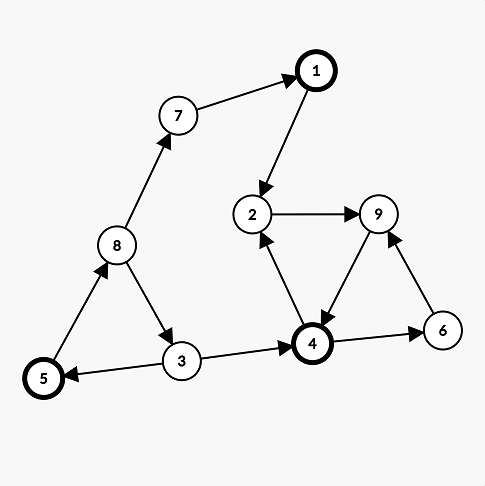- 翰林提供学术活动、国际课程、科研项目一站式留学背景提升服务!
- 400 888 0080
USACO 2020 US Open Contest, Gold Problem 2. Favorite Colors
USACO 2020 US Open Contest, Gold Problem 2. Favorite Colors
Each of Farmer John's NN cows (1≤N≤2⋅1051≤N≤2⋅105) has a favorite color. The cows are conveniently labeled 1…N1…N (as always), and each color can be represented by an integer in the range 1…N1…N.
There exist MM pairs of cows (a,b)(a,b) such that cow bb admires cow aa (1≤M≤2⋅1051≤M≤2⋅105). It is possible that a=ba=b, in which case a cow admires herself. For any color cc, if cows xx and yy both admire a cow with favorite color cc, then xx and yy share the same favorite color.
Given this information, determine an assignment of cows to favorite colors such that the number of distinct favorite colors among all cows is maximized. As there are multiple assignments that satisfy this property, output the lexicographically smallest one (meaning that you should take the assignment that minimizes the colors assigned to cows 1…N1…N in that order).
INPUT FORMAT (file fcolor.in):
The first line contains NN and MM.The next MM lines each contain two space-separated integers aa and bb (1≤a,b≤N1≤a,b≤N), denoting that cow bb admires cow aa. The same pair may appear more than once in the input.
OUTPUT FORMAT (file fcolor.out):
For each ii in 1…N1…N, output the color of cow ii in the desired assignment on a new line.
SAMPLE INPUT:
9 12 1 2 4 2 5 8 4 6 6 9 2 9 8 7 8 3 7 1 9 4 3 5 3 4
SAMPLE OUTPUT:
1 2 3 1 1 2 3 2 3
In the image below, the circles with bolded borders represent the cows with favorite color 1.

SCORING:
- Test cases 2-3 satisfy N,M≤103N,M≤103.
- Test cases 4-10 satisfy no additional constraints.
Problem credits: William Lin and Benjamin Qi
USACO 2020 US Open Contest, Gold Problem 2. Favorite Colors 题解(翰林国际教育提供,仅供参考)
[/hide]
(Analysis by Benjamin Qi)
If both cows bb and cc admire cow aa then both bb and cc must have the same color. From now on, we can treat both bb and cc as the same cow; change all occurrences of cc to bb and merge the adjacency list of cc into that of bb. Repeat this process while at least two distinct cows admire the same cow.
Once we reach a configuration in which a cow is admired by at most one cow this process terminates; we can just assign every cow a distinct color. If we always merge the smaller adjacency list of the two cows into the larger one then our solution runs in O((N+M)logN)O((N+M)logN) time. We ensured that a few slow solutions did not pass but it is likely that many (not necessarily provable) heuristics passed anyways.
#include <bits/stdc++.h>
using namespace std;
void setIO(string s) {
ios_base::sync_with_stdio(0); cin.tie(0);
freopen((s+".in").c_str(),"r",stdin);
freopen((s+".out").c_str(),"w",stdout);
}
const int MX = 2e5+5;
int N,M;
int par[MX],cnt[MX];
vector<int> adj[MX], rpar[MX];
queue<int> q;
void merge(int a, int b) {
a = par[a], b = par[b];
if (rpar[a].size() < rpar[b].size()) swap(a,b);
for (int t: rpar[b]) { par[t] = a; rpar[a].push_back(t); }
adj[a].insert(end(adj[a]),begin(adj[b]),end(adj[b]));
adj[b].clear();
if (adj[a].size() > 1) q.push(a);
}
int main() {
setIO("fcolor");
cin >> N >> M;
for (int i = 0; i < M; ++i) {
int a,b; cin >> a >> b;
adj[a].push_back(b);
}
for (int i = 1; i <= N; ++i) {
par[i] = i; rpar[i].push_back(i);
if (adj[i].size() > 1) q.push(i);
}
while (q.size()) {
int x = q.front(); if (adj[x].size() <= 1) { q.pop(); continue; }
int a = adj[x].back(); adj[x].pop_back();
if (par[a] == par[adj[x].back()]) continue;
merge(a,adj[x].back());
}
int co = 0;
for (int i = 1; i <= N; ++i) {
if (!cnt[par[i]]) cnt[par[i]] = ++co;
cout << cnt[par[i]] << "n";
}
}
[/hide]

最新发布
© 2025. All Rights Reserved. 沪ICP备2023009024号-1









